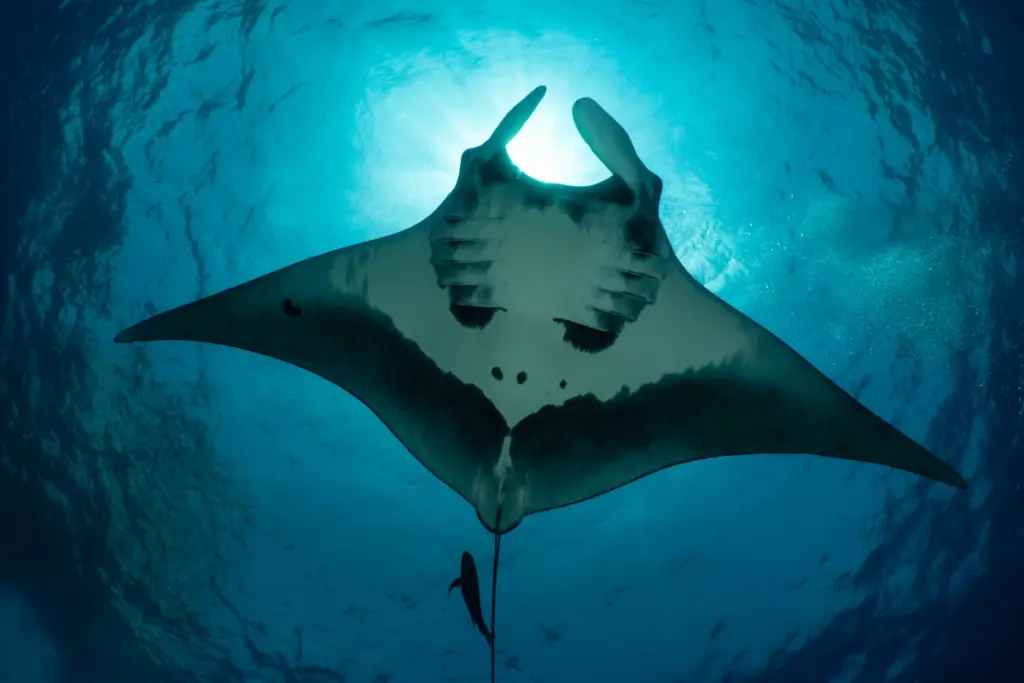
Researchers have discovered that oceanic manta rays regularly perform extreme dives exceeding 1,200 meters, roughly three-quarters of a mile, not for feeding but as a means of navigation. An international team of scientists from Peru, Indonesia, and New Zealand has found that these dives are essential for the mantas to recalibrate their spatial awareness as they travel beyond the continental shelf.
The study, which involved tagging 24 manta rays (Mobula birostris), revealed that these creatures, with an average wingspan of 13 to 15 feet (4 to 4.5 meters), dive deeper than previously documented. According to Dr. Calvin Beale, the first author who completed his PhD at Murdoch University, “These dives, linked with increased horizontal travel afterwards, may play an important role in helping mantas gather information about their environment and navigate across the open ocean.”
Data collected over the study period included 2,705 tag-days, revealing that on 79 occasions, manta rays dived to depths of up to 1,250 meters (0.78 miles). Notably, the majority of these deep dives occurred off the coast of New Zealand, where the underwater topography—characterized by a sudden drop-off from the continental shelf—requires the mantas to recalibrate their navigational maps.
Understanding Manta Navigation Through Depth
The research indicates that individual manta rays undertook their first extreme dives shortly after moving offshore. These dives were not steep descents aimed at hunting or escaping predators. Instead, the rays adopted a stepped pattern, spending minimal time at the maximum depth before ascending in a similar manner. After such dives, they often traveled significant distances, sometimes reaching up to 200 kilometers (124 miles) over subsequent days.
The scientists suggest that the mantas are attuned to environmental cues like magnetic field variations, oxygen levels, temperature, and light changes to help them navigate vast, featureless ocean expanses. “By diving down and ‘sampling’ these signals, they could build a mental map that helps them navigate across vast, featureless stretches of open ocean,” stated Dr. Mark Erdmann, Shark Conservation Director at Re:wild and co-author of the study.
The findings indicate that the deep dives coincide with the mantas’ northward migration after leaving the continental shelf. According to Erdmann, “The study shows that immediately after deep dives, NZ oceanic mantas spend a fair bit of time warming up on the surface, likely recovering from the thermal stress of these very cold deep waters. They then start moving ‘with a purpose’—covering up to 200 km per day in a highly directional manner.”
The Importance of Deep Dives in Conservation Efforts
The depth of the dives is crucial for the mantas’ navigational accuracy, as conditions are more stable and predictable at greater depths compared to the surface. The research highlights how essential the deep ocean is for these endangered species, which rely on areas that remain largely unexplored by scientists.
“Understanding the nature and function of deep dives helps explain how animals cross vast, seemingly featureless oceans and connect ecosystems thousands of kilometers apart,” Beale explained. The study, though limited to a small sample size of 24 individuals, sets the groundwork for future research aimed at confirming the navigational purposes of these extreme dives.
In conclusion, the study emphasizes the interdependence of migratory species on diverse habitats and the urgent need for international cooperation in conservation efforts. “Our study highlights how dependent migratory species are on both coastal and offshore habitats, stressing the need for international cooperation in their conservation,” Beale stated. “It also reminds us that the deep ocean, which regulates Earth’s climate and underpins global fisheries, remains poorly understood but vitally important.”
The research was published in the journal Frontiers in Marine Science, shedding light on the remarkable navigational abilities of oceanic manta rays.







